Search results for 'Assignment'
-
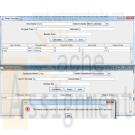
PRG 421 Week 2 GUI Components Program
$20.00PRG 421 Week 2 GUI Components Program
Learn More
For this assignment, you will choose from the following options:
Option 1: Retail Calculator
A retailer would like a calculator to indicate sale prices when he marks items down at various percentages.
Design, implement, test, and debug a GUI application that allows the retailer to enter the item’s name, the item’s original price, and the percentage discounted.
• The application should include a Calculate button that, when pressed, computes and displays the sale price in a label or text field.
• The program should allow the retailer to enter any number of items in this manner.
• Include an Exit button to end the execution of the application.
• The program should allow the user to select a department from a menu. You may create the menu as a true menu, a JComboBox, or radio buttons.
• Create your own list to populate the menu: men’s clothing, women’s clothing, house wares, and so forth.
• Include at least five departments.
• Create a JTextArea or a JTable to display each of the following for each item entered:
o Item name
o Department
o Original price
o Sale price
Option 2: Payroll Application
An employer is looking for an easier way to track employee pay.
Design, implement, test, and debug an application to compute an employee’s weekly pay. If the employee works more than 40 hours a week, the employee earns 1.5 times the basic hourly pay for any time worked over 40 hours. The program should allow the user to input the employee’s name, the number of hours worked, and the hourly rate.
• The application should include a Calculate button that, when pressed, computes and displays the total pay in a label or text field.
• The program should allow the user to enter information for any number of employees in this manner.
• Include an Exit button to end the execution of the application.
• The program should allow the user to select the employee’s department from a menu. This can be a standard menu, radio buttons, or a JComboBox.
• Create your own list to populate the menu: Marketing, IT, Accounting, and so forth.
• Include at least five departments.
• Validate the employee’s hourly wage and hours worked according to the following rules:
The hourly wage must be at least $6 per hour and cannot be more than $150 per hour. It must be numeric.
The hours worked must be a numeric value greater than or equal to 0 and cannot be greater than 60.
• Create a JTextArea, JTable, or other form of a table to your application and use that to list the following for every employee:
o Name
o Department
o Weekly salary
Add each employee to the list after you have computed that employee’s salary. -

PRG 421 Week 3 Contact Information Program
$15.00PRG 421 Week 3 Contact Information Program
Learn More
This is a two-part assignment.
Part 1
Design, implement, test, and debug a program with a JFrame that allows the user to enter a series of contacts’ names, ages, e-mail addresses, and cell phone numbers, and creates a file from the entered data. Validate the age entry to ensure that it is numeric and between 0 and 120. Include information for three to five contacts.
Part 2
Design, implement, test, and debug a program that reads the file you created by the list in Part 1 and displays the records in a JFrame. You may either display all entries in the list at once or display them one at a time; the user interface is up to you. Protect against not being able to open the file.
Submit the .java source files. -
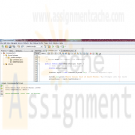
PRG 420 Week 2 Simple Commission Calculation Program Part 1
$15.00PRG 420 Week 2 Simple Commission Calculation Program Part 1
Learn More
Write a Java™ application using NetBeans™ Integrated Development Environment (IDE) that calculates the total annual compensation of a salesperson. Either a GUI graphic user interface) program or non-GUI program is acceptable. Consider the following factors:
• A salesperson will earn a fixed annual salary of $25,000.00.
• A salesperson will also receive a commission as a sales incentive. Commission is a percentage of the salesperson’s annual sales. The current commission is 10% of total sales.
• The total annual compensation is the fixed salary plus the commission earned.
The Java™ application should meet these technical requirements:
Create a NetBeans project and name it XXXIA2. XXX is your last name. It is important to use your last name so that each student’s project name is unique. When your team evaluation the members’ program, the team will know whom the program belong to. Your system can also load in multiple projects without conflicting project names. The number 2 in the file name is the academic week number.
• The application should have at least one class, in addition to the application’s controlling class (a controlling class is where the main function resides).
• There should be proper documentation in the source code.
• The application should ask the user to enter annual sales, and it should display the total annual compensation.
Because NetBeans produces multiple files for one project, the best method to submit an assignment is to zip the files. There should be one project folder created by NetBeans using your project name. Zip the folder. Submit your NetBeans project zip file. -

PRG 420 Week 3 Simple Commission Calculation Program Part 2
$15.00PRG 420 Week 3 Simple Commission Calculation Program Part 2
Learn More
Modify the Week Two Java™ application using Java™ NetBeans™ IDE to meet these additional and changed business requirements. Either a GUI (graphic user interface) program or non-GUI program is acceptable.
• The company has recently changed its total annual compensation policy to improve sales.
• A salesperson will continue to earn a fixed salary of $25,000.00. The current sales target for every salesperson is $120,000.
• The sales incentive will only start when 80% of the sales target is met. The current commission is 10% of total sales.
• If a salesperson exceeds the sales target, the commission will increase based on an acceleration factor. The acceleration factor is 1.25 which means all sales above the sales target will be earning 25% commission.
• The application should ask the user to enter annual sales, and it should display the total annual compensation.
• The application should also display a table of potential total annual compensation that the salesperson could have earned, in $5000 increments above the salesperson’s annual sales, until it reaches 50% above the salesperson’s annual sales.
Sample Table: Assuming a total annual sales of $100,000, the table would look like this:
Total Sales Total Compensation
100,000 <<Program calculated value>>
105,000 <<Program calculated value>>
110,000 <<Program calculated value>>
115,000 <<Program calculated value>>
120,000 <<Program calculated value>>
125,000 <<Program calculated value>>
130,000 <<Program calculated value>>
135,000 <<Program calculated value>>
140,000 <<Program calculated value>>
145,000 <<Program calculated value>>
150,000 <<Program calculated value>>
The Java™ application should also meet these technical requirements:
Create a NetBeans project and name it XXXIA3. XXX is your last name. It is important to use your last name so that each student’s project name is unique. When your team evaluation the members’ program, the team will know whom the program belong to. Your system can also load in multiple projects without conflicting project names. The number 3 in the file name is the academic week number.
• The application should have at least one class, in addition to the application’s controlling class.
• The source code must demonstrate the use of conditional and looping structures.
• There should be proper documentation in the source code.
Because NetBeans produces multiple files for one project, the best method to submit an assignment is to zip the files. There should be one project folder created by NetBeans using your project name. Zip the folder. Submit your NetBeans project zip file. -

PRG 420 Week 4 Simple Commission Calculation Program Part 3
$15.00PRG 420 Week 4 Simple Commission Calculation Program Part 3
Learn More
Modify the Week Three Java™ application using Java™ NetBeans™ IDE to meet these additional and changed business requirements. Either a GUI (graphic user interface) program or non-GUI program is acceptable.
• The application will now compare the total annual compensation of at least two salespersons.
• It will calculate the additional amount of sales that each salesperson must achieve to match or exceed the higher of the two earners.
• The application should ask for the name of each salesperson being compared.
The Java™ application should also meet these technical requirements:
Create a NetBeans project and name it XXXIA4. XXX is your last name. It is important to use your last name so that each student’s project name is unique. When your team evaluation the members’ program, the team will know whom the program belong to. Your system can also load in multiple projects without conflicting project names. The number 4 in the file name is the academic week number.
• The application should have at least one class, in addition to the application’s controlling class.
• The source code must demonstrate the use of Array or ArrayList.
• There should be proper documentation in the source code.
Because NetBeans produces multiple files for one project, the best method to submit an assignment is to zip the files. There should be one project folder created by NetBeans using your project name. Zip the folder. Submit your NetBeans project zip file. -
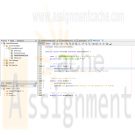
CMIS 141 Project 3 Stringed Musical Instrument Java Class and UML class diagram
$25.00CMIS 141 Project 3 Stringed Musical Instrument Java Class and UML class diagram
This project focuses on demonstrating your understanding of classes and objects. Before attempting this project, be sure you have completed all of the reading assignments listed in the syllabus to date, participated in the weekly conferences, and thoroughly understand the examples throughout the chapters. The project requirements include:
1. Design and implement a stringed musical instrument class using the following guidelines:
a. Data fields for your instrument should include number of strings, an array of string names representing string names (e.g. E,A,D,G), and boolean fields to determine if the instrument is tuned, and if the instrument is currently playing. You are welcome to add additional data fields if you like.
b. A constructor method that set the tuned and currently playing fields to false.
c. Other methods 1) to tune the instrument, 2) to start the instrument playing, and 3) to stop the instrument from playing.
d. Other methods as you see fit (Add at least one unique method).2. Create a UML class diagram using a diagram tool (e.g. PPT, Visio) of your choice. Prepare the diagrams and place them in a word document along with a brief description of each of your classes.
3. Create Java classes for your instruments. Be sure that your code matches your design specifications and some minimal functionality is included. For example, if you called the violin.play() method, you should at least print that the violin is playing. Similar functionality should be supplied when you stop playing, tune or call any of your methods. For example:
public void playviolin() {
System.out.println("The violin is now playing.");
}4. Write the output from your Instrument class methods to a text file that a user entered from the command line arguments (e.g. java Mynamep3tst myfilename.txt). This allows your program to accept filenames from the user via a command line argument.
5. Finally, create a Java test class that simulates using your instrument class. In your test class be you should at a minimum: a) Construct 10 instances of your instrument, b) tune your instruments, c) Start playing your instrument, d) Call your unique method, and e) Stop playing your instruments. (Hint: Arrays and Loops will make your job easier and result in more efficient code!)
6. Your programs should compile and run without errors.
7. Be sure to test your program carefully. Provide a list of comprehensive test cases used to validate your application and include these test cases in your word document containing your UML diagrams and descriptions. Similar to Project 1, your test data can be shown in a table that includes input data, expected output, actual output and pass/fail results from the test.
Learn More -
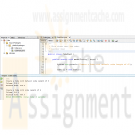
CMIS 141 Homework 4 Cube Class
$12.00CMIS 141 Homework 4 Cube Class
Design and implement a Java class to represent a cube class. The class should contain at least one constructor, appropriate data fields and separate methods to return the volume of the cube, and the surface area of the cube. Name your Java file Yournamehw4.java.
Homework 4 Submission requirements:
Learn More
Your completed assignment should consist of the Yournamehw4.java Java file. Submit this file, along with the java program that you used to test the Cube class, and screenshots showing that yourprogram compiled and ran, to your WebTycho homework 4 assignment area no later than the due date. Please make sure to include the Test Cube class program as well. -
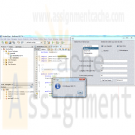
Dreams Travel Agency Java GUI Both parts
$20.00Dreams Travel Agency Java GUI Both parts
Learn More
Field of Dreams Travel Agency has begun offering travel packages to baseball fans wanting to attend major league baseball games. The company offers a package allowing a fan to attend games in four cities of his or her choice, including transportation by car, tickets, lodging, and food. Assume that the fan lives in the city hosting one of the 30 major league baseball teams. The fan will travel from his or her home to the city of one of the teams of his choice, then will proceed to the city of one of the other teams and so on until all teams have been visited. Then, the fan will return home. Create a Java program that will compute the minimum cost of the trip. Your cost will be the cost of transportation (fuel cost per gallon/ miles per gallon * number of miles between ballparks), cost of tickets, cost of lodging, and cost of food. Ask the user his home city, which cities he wants to visit, the price of fuel, the fuel economy of his vehicle, the cost of lodging per day and the cost of food per day. Your program will compute the costs of all 24 possible routings and choose the minimum cost route. Mark up the minimum cost by 20% to arrive at the cost that will be quoted to the customer.
For this week, you need only to create the GUI using Java Swing and create the basic classes that will accept the inputs from the user. We will create the functionality of these classes in the second assignment.
We will discuss strategies for preparing this program in the first week of class and you can create the program in the second week of class. That is done and I have a program with no function so here is the second part: Expand the model classes you created in the first assignment. Implement the functionality that will use the inputs offered by the user and prepare a quote for the customer according to the requirements specified in the first assignment. Upon clicking a Quote button on the GUI, the program should post a dialog box with the quote. Upon clicking the Print Quote button, write the quote out to a text file. This program was built on NETBEANS -
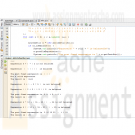
COP3804 Assignment 4 Infix to Postfix
$15.00COP3804 Assignment 4 Infix to Postfix
The concept of stack is extremely important in computer science and is used in a wide variety of problems. This assignment requires you to write a program that can be used to evaluate ordinary arithmetic expressions that contains any of the five arithmetic operators (+, -, *, /, %).
This exercise requires three distinct steps, namely:
1. Verify that the infix arithmetic expression (the original expression), that may contain regular parentheses, is properly formed as far as parentheses are concerned.
2. If the parenthesized expression is properly formed, convert the expression from an infix expression to its equivalent postfix expression, called Reverse Polish Notation (RPN) named after the Polish Mathematician J. Lukasiewics.
3. Evaluate the postfix expression, and print the result.Step 1 - Verify that the expression
Given an arithmetic expression, called an infixed expression, to verify that it is properly formed as far as parentheses are concerned, do the following:
• Create an empty stack to hold left parenthesis ONLY.
• Scanned the arithmetic expression from left to right, one character at a time.
• While there are more characters in the arithmetic expression
{
If the character is a left parenthesis ‘(‘, push it on to the stack. However if the character is a right parenthesis, ‘)’, visit the stack and pop the top element from off the stack.
}
• If the stack contains any element at the end of reading the arithmetic expression, then the expression was not properly formed.Step 2 - Convert infixed expression to postfix
Given that an arithmetic expression is properly form with respect to parentheses, do the following:
• Create an empty stack to hold any arithmetic operators and left parenthesis, ONLY.
• A string to contain the postfix expression – the output from this conversion.
• Scan the arithmetic expression from left to right.
• While the are more symbols in the arithmetic expression,
{
After a symbol is scanned, there are four (4) basic rules to observed and apply accordingly:
1. If the symbol is an operand (a number), write it to the output string.
2. If the symbol is an operator and if the stack is empty, push the symbol on the stack.
Otherwise, if the symbol is either ‘(‘ or ‘)’, check for the following conditions:
If the symbol is ‘(‘, push on to the stack,
Otherwise
If the symbol is ‘)’
{
Pop everything from the operator stack down to the first ‘(‘. Write each item
popped from the stack to the output string. Do not write the item ‘)’. Discard it.
}
3. If the symbol scanned is an arithmetic operator, check for the following and apply accordingly:
If the operator on the top of the stack has higher or equal precedence, that operator is popped from off the stack, and is written to the to the output string. This process is continues until one of two things happen:
(a) Either the first ‘(‘ is encountered. When this occurs, the ‘(‘ is removed from the stack and is discarded, and the recently scanned symbol is placed on the stack
OR
(b) The operator on the stack has lower precedence than the one just scanned. When this situation arises, the recently scanned symbol is pushed onto the stack.
}
4. After the arithmetic expression is exhausted, any operator is remaining on the stack must be popped from off and is written to the output string.Step 3 - Evaluate the post fixed expression
Initialize an empty stack.
While there are more symbols in the postfix string
{
? If the token is an operand, push it onto the stack.
? If the token is an operator
{
Pop the two topmost values from the stack, and store them in the order t1, the topmost, and t2 the second value.
Calculate the partial result in the following order t2 operator t1
Push the result of this calculation onto the stack.
NOTE: If the stack does not have two operands, a malformed postfix expression has occurred, and evaluation should be terminated.
}
}
When the end of the input string is encountered, the result of the expression is popped from the stack.
NOTE: If the stack is empty or if it has more than one operand remaining, the result is unreliable.Extend this algorithm to include square brackets and curly braces. For example, expressions of the following kind should be considered
2 + { 2 * ( 10 – 4 ) / [ { 4 * 2 / ( 3 + 4) } + 2 ] – 9 }
2 + } 2 * ( 10 – 4 ) / [ { 4 * 2 / ( 3 + 4) } + 2 ] – 9 {Implement the above two algorithms for the following binary operators: addition +, subtraction -, multiplication *, division /, and modulus operation %. All operations are integer operations. To keep things simple, place at least one blank space between each token in the input string.
Use the following code below as your Main Test class:
class RPN
{
public static void main(String[] arg)
{
String s[] = {"5 + ) * ( 2",
" ( { [ } ) ] ",
" 2 + ] - 3 * 5 [ ",
"[( 2 + 3 ) * 5] * 8 ",
"5 * 10 + ( 15 - 20 ) ) - 25",
"5 * { 10 + ( 15 - 20 ) } - 25",
" 5 + [ 5 * { 10 + ( 15 - 20 ) } - 25 ] * 9"
};
for (int i = 0; i < s.length; i++)
{Arithmetic a = new Arithmetic(s[i]);
Learn More
if (a.isBalance())
{
System.out.println("Expression " + s[i] + " is balanced\n");
a.postfixExpression();
System.out.println("The post fixed expression is " + a.getPostfix());
a.evaluateRPN();
System.out.println("The result is : " + a.getResult() + "\n" );
}
else
System.out.println("Expression is not balanced\n");
}
}
} -
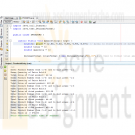
ITS 320 Assignment 3 Decision Control and Loops with User Interaction
$15.00ITS 320 Assignment 3 Decision Control and Loops with User Interaction
1) Write a Java application that prompts the user for pairs of inputs of a product number (1-5), and then an integer quantity of units sold (this is two separate prompts for input values). You must use a switch statement and a sentinel – controlled loop (i.e. a loop that stops execution when an out of range value, such as -1, is input). All 15 items below are for a single purchase. There are five sets of inputs as follows:
Product 1 1 unit (cost is $2.98 per unit)
Product 2 2 units (cost is $4.50 per unit)
Product 3 3 units (cost is $9.98 per unit
Product 4 4 units (cost is $4.49 per unit)
Product 5 5 units (cost is $6.87 per unit)
Your application must calculate and display the total retail value of all products sold, after all 5 pairs of inputs are completed. You must also display the total after each new pair of input values is entered. (This program was taken from Exercise 5.17 on page 228 of Deitel & Deitel's "Java How to Program (Sixth Edition)" (2005 by Pearson Publishing Co.))2) You may use the Windows Command Prompt command line interface or any Java IDE you choose to compile and execute your program.
3) You are to submit the following deliverables to the Assignment Dropbox in a single Microsoft Word file:
A screen snapshot of your Java source code (just the beginning is OK) as it appears in your IDE (e.g. jGRASP, Net Beans, Eclipse, etc.) or editor (e.g. a Windows Command Prompt DOS "more" of the .java file's first screen).
A listing of your entire Java source code in the same Microsoft Word file as item a), and following item a). You can simply copy and paste the text from your IDE into Word. Be sure to maintain proper code alignment by using Courier font for this item.
A screen snapshot of your program’s input and output in the same Microsoft Word file, and following item b). You must include screen snapshots of all inputs and all outputs,not just a sample.4) Your instructor may compile and run your program to verify that it compiles and executes properly.
5) You will be evaluated on (in order of importance):
Learn More
Inclusion of all deliverables in Step #3.
Correct execution of your program.
Adequate commenting of your code.
Good programming style (as specified in the textbook's examples).
Neatness in packaging and labeling of your deliverables




